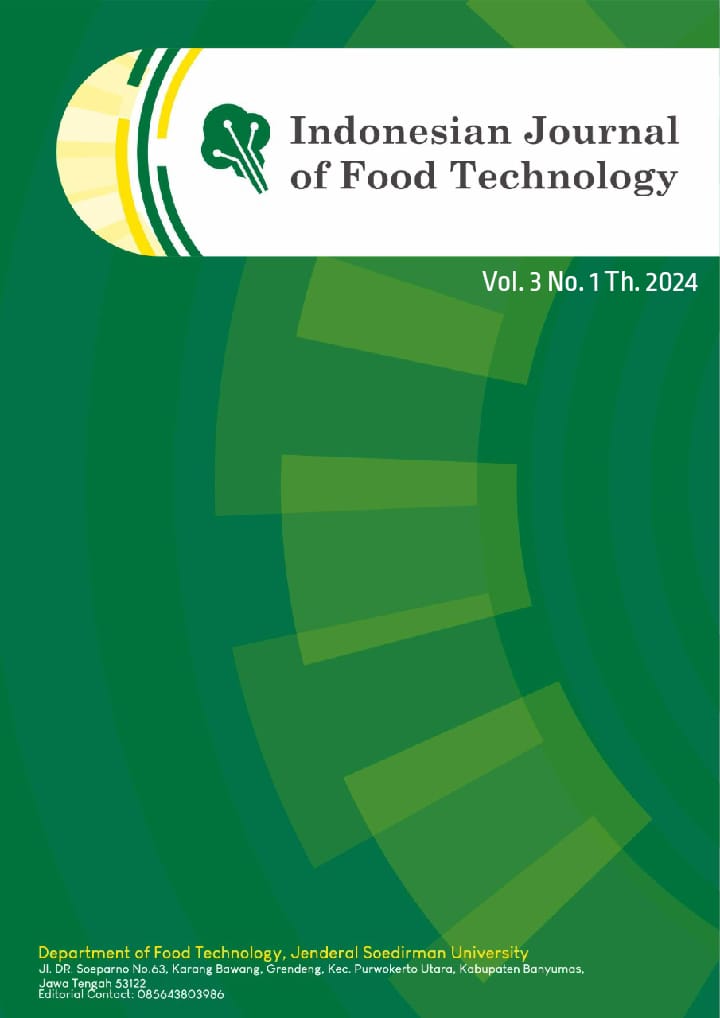The Effect of Drying Temperature and Time on The Chemical Characteristic, Total Phenolic Content, and Organoleptic Properties of Black Garlic Herbal Tea
Abstract
Black garlic is a functional food known to be beneficial for health. Most people favor the organoleptic properties produced, so it needs handling to improve, namely by drying, which produces black garlic herbal tea products. This study aims to determine the effect of drying temperature and time on chemical characteristics, total phenolic content, and the organoleptic properties of black garlic herbal tea. The experiment was conducted with a two-factor, completely randomized design. The first factor is drying temperature, which consists of two levels (50 and 60⁰C). The second factor is drying time, which consists of two levels (5 and 6 hours). The observation results were analyzed using analysis of variance (ANOVA) and continued with DMRT further test at a 5 % confidence level. The results showed that black garlic herbal tea's temperature and drying time significantly affected chemical characteristics, total phenolic content, and color but had no significant effect on aroma, taste, and overall. The chemical characteristic results in the 60 ⁰C drying temperature for 6 hours contained 7.65 % moisture content, 2.98 % ash, and 4.06 mgGAE/g total phenolic content.
References
Ali, Mukhti. (2016). Optimasi Pengolahan Teh Kulit Buah Naga (Hylocereus polyrhizus). Jurnal Ilmu dan Teknologi Pertanian, 3(1), 216-223. https://doi.org/10.37676/agritepa.v3i1.305
AOAC (Association of Official Analytical Chemyst). (2005). Official Method of Analysis of The Association of Official Anlytical of Chemist. USA: Association of Analytical Chemist, Inc.
Ariva, A, N., Widyasanti, A., & Nurjanah, S. (2020). Pengaruh Suhu Pengeringan terhadap Mutu Teh Cascara dari Kulit Kopi Arabika (Coffea arabica). Jurnal Teknologi dan Industri Pertanian Indonesia, 12(1), 21-28. https://doi.org/10.17969/jtipi.v12i1.15744
Arumsari, K., Aminah, S., & Nurrahman. (2019). Aktivitas Antioksidan dan Sifat Sensoris Teh Celup Campuran Bunga Kecombrang, Daun Mint dan Daun Stevia. Jurnal Pangan dan Gizi, 9(2), 128-140. http://dx.doi.org/10.26714/jpg.9.2.2019.79-93
Asiah, N., & Djaeni, M. (2021). Konsep Dasar Proses Pengeringan Pangan. AE Publishing.
B, Nurhidayah., Soekendarsi, E., & Erviani, A, E. (2019). Kandungan Kolagen Sisik Ikan Bandeng Chanos-chanos dan Sisik Ikan Nila Oreochromis niloticus. BIOMA: Jurnal Biologi Makassar, 4(1), 39-47. https://doi.org/10.20956/bioma.v4i1.6341
BSN. (2014). SNI 3753:2014 : Teh Hitam Celup. Jakarta: Badan Standardisasi Nasional.
Etika, M., & Giyatmi. (2020). Pengaruh Suhu dan Lama Pengeringan terhadap Mutu Teh Daun Ketul (Bidens pilosa L.). Jurnal Teknologi Pangan dan Kesehatan, 2(1), 13-25. https://doi.org/10.36441/jtepakes.v2i1.496
Fatima, S., & Masriani, M. (2019). Lama Penyimpanan Mutu Organoleptik Fresh Cut Wortel Segar (Daucus carota L). Jurnal Ilmu Pertanian, 2(3), 1-7. https://doi.org/10.35334/jpen.v2i3.1563
Kim, J, S., Kang, O, J., & Gweon, O, C. (2013). Comparison of Phenolic Acids and Flavonoids in Black Garlic At Different Thermal Processing Steps. Journal of Functional Foods, 5(1), 80- 86. https://doi.org/10.1016/j.jff.2012.08.006
Kimura, S., Tung, Y, C., Pan, M, H., Su, N, W., Lai, Y, J., & Cheng, K, C. (2017). Black Garlic: A Critical Review of its Production, Bioactivity, and Application. Food and Drug Analysis, 25(1), 62-70. https://doi.org/10.1016/j.jfda.2016.11.003
Kosnayani, A, S., Yunianto, A, E., & Rizal, M, E, A. (2022). Metode Penyeduhan terhadap Nilai Kesukaan dan Aktivitas Antioksidan Seduhan Teh Meniran (Phyllanthus niruri Linn.). Aceh Nutrition Journal, 7(1), 1-7. http://dx.doi.org/10.30867/action.v7i1.459
Lisa, M., Lutfi, M., & Susilo, B. (2015). Pengaruh Suhu dan Lama Pengeringan terhadap Mutu Tepung Jamur Tiram Putih (Plaerotus ostreatus). Jurnal Keteknikan Pertanian Tropis dan Biosistem, 3(3), 270-279. http://dx.doi.org/10.21776/jkptb.v3i3.293
Nurjanah, F. (2020). Pengaruh Pelarut Purifikasi terhadap Kadar Fenolik Total Ekstrak Biji Kopi Hijau Arabika (Coffea arabica L.). (Skripsi Sarjana, Universitas Ngudi Waluyo). http://repository2.unw.ac.id/806/4/Lampiran%20Depan%20-%20fitri%20nurjanah.pdf
Palupi, M, R., & Widyaningsih, T, D. (2015). Pembuatan Minuman Fungsional Liang Teh Daun Salam (Eugenia polyantha) dengan Penambahan Filtrat Jahe dan Filtrat Kayu Secang. Jurnal Pangan dan Agroindustri, 3(4), 1458-1464.
https://jpa.ub.ac.id/index.php/jpa/article/view/269
Pramitha, D, A, I., & Sundari, N, K, G. (2020). Kapasitas Antioksidan pada Bawang hitam Tunggal dan Majemuk secara In-Vitro dengan DPPH. Jurnal Ilmiah Medicamento, 6(2), 79-83. https://dx.doi.org/10.36733/medicamento.v6i2.1030
Sailah, I., & Miladulhaq, M. (2021). Perubahan Sifat Fisikokimia Selama Pengolahan Bawang Putih Tunggal Menjadi Bawang Hitam Menggunakan Rice Cooker. Jurnal Teknologi Industri Pertanian, 31(1), 88-97. http://repository.ipb.ac.id/handle/123456789/95561
Sam, S., Malik, A., & Handayani, S. (2016). Penetapan Kadar Fenolik Total dari Ekstrak Etanol Bunga Rosella Berwarna Merah (Hibiscus sabdariffa L.) dengan Menggunakan Spektrofotometer UV-Vis. Jurnal Fitofarmaka Indonesia, 3(2), 182-187. https://doi.org/10.33096/jffi.v3i2.220
Sarkar, A., Rashid, M., Musarrat, M., & Millah, M. (2021). Drying Effects on Phytochemicals and Antioxidant Properties of Ginger Powder Undergoing Different Drying Techniques. European Journal of Agriculture and Food Sciences, 3(1), 128-132. https://www.ejfood.org/index.php/ejfood/article/download/236/126/765
Sayekti, D. (2016). Aktivitas Antioksidan Teh Kombinasi Daun Katuk dan Daun Kelor dengan Variasi Suhu Pengeringan. Skripsi. Fakultas Keguruan dan Ilmu Pendidikan. Solo: Universitas Muhammadiyah Surakarta.
Sida, S., Samakradhamrongthai, R, S., & Utama-ang, N. (2019). Influence of Maturity and Drying Temperature on Antioxidant Activity and Chemical Compositions in Ginger. Current Applied Science and Technology, 19(1), 28-42. https://li01.tci- thaijo.org/index.php/cast/article/view/150590
Suwarsih., Wulandari, Y, W., & Widanti, Y, A. (2020). Aktivitas Antioksidan Black Garlic dengan Variasi Jenis Bawang (Allium sp) dan Lama Pemeraman. JITIPARI0, 5(1). https://doi.org/10.33061/jitipari.v5i1.3092
Tuapattinaya, P, M, J., Simal, R., & Warella, J, C. (2021). Analisis Kadar Air dan Kadar Abu Teh Berbahan Dasar Daun Lamun (Enhalus acoroides). Jurnal Biologi, Pendidikan, dan Terapan, 8(1), 16-21. https://doi.org/10.30598/biopendixvol8issue1page16-21
Ulandari, D, A, T., Nocianitri, K, A., & Arihantana, N, M, I, H. (2019). Pengaruh Suhu Pengeringan terhadap Kandungan Komponen Bioaktif dan Karakteristik Sensoris Teh White Peony. Jurnal Ilmu dan Teknologi Pangan, 8(1), 36-47.
https://doi.org/10.24843/itepa.2019.v08.i01.p05
Wang, D., Feng, Y., Liu, J., Yan, J., Wang, M., Sasaki, J, I., & Lu, C. (2010). Black Garlic (Allium sativum) Extracts Enhance the Immune System. Medicinal and Aromatic Journal of Plant Science and Biotechnology, 4(1), 37-40. https://www.semanticscholar.org/paper/Black- Garlic-(-Allium-sativum-)-Extracts-Enhance-Wang- Feng/8cedcb2baa07137e1a75f0a1d24ab55a9959c848
Yuniar, Nurdianis, Khorisna. (2018). Pengaruh Suhu Pengeringan dan Lama Waktu Pengeringan terhadap Senyawa Fenolik dan Aktivitas Antioksidan Bubuk Bawang Hitam (Allium sativum L.). (Skripsi Sarjana, Universitas Brawijaya). http://repository.ub.ac.id/id/eprint/165033











